Related Research Articles
A roof is the top covering of a building, including all materials and constructions necessary to support it on the walls of the building or on uprights, providing protection against rain, snow, sunlight, extremes of temperature, and wind. A roof is part of the building envelope.

Thatching is the craft of building a roof with dry vegetation such as straw, water reed, sedge, rushes, heather, or palm branches, layering the vegetation so as to shed water away from the inner roof. Since the bulk of the vegetation stays dry and is densely packed—trapping air—thatching also functions as insulation. It is a very old roofing method and has been used in both tropical and temperate climates. Thatch is still employed by builders in developing countries, usually with low-cost local vegetation. By contrast, in some developed countries it is the choice of some affluent people who desire a rustic look for their home, would like a more ecologically friendly roof, or who have purchased an originally thatched abode.

Sejong, personal name Yi To, commonly known as Sejong the Great, was the fourth monarch of the Joseon dynasty of Korea. He is regarded as one of the greatest rulers in Korean history, and is remembered as the inventor of Hangul, the native alphabet of the Korean language.

Namdaemun, officially known as the Sungnyemun, is one of the Eight Gates in the Fortress Wall of Seoul, South Korea. The gate formed the original southern boundary of the city during the Joseon period, although the city has since significantly outgrown this boundary. It is located in Jung-gu between Seoul Station and Seoul Plaza, with the historic 24-hour Namdaemun Market next to the gate.
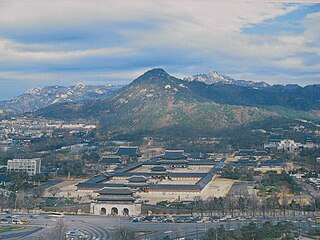
Gyeongbokgung, also known as Gyeongbokgung Palace, was the main royal palace of the Joseon dynasty. Built in 1395, it is located in northern Seoul, South Korea. The largest of the Five Grand Palaces built by the Joseon dynasty, Gyeongbokgung served as the home of the royal family and the seat of government.

Korean architecture refers to an architectural style that developed over centuries in Korea. Throughout the history of Korea, various kingdoms and royal dynasties have developed a unique style of architecture with influences from Buddhism and Korean Confucianism.

The history of Seoul can be traced back as far as 18 BC, although humans have occupied the area now known as Seoul since the Paleolithic Age. It has been the capital of numerous kingdoms on the Korean Peninsula since it was established.
The Second Great Fire of London in December 1940 was caused by one of the most destructive air raids of the Blitz during World War II. The Luftwaffe raid caused fires over an area greater than that of the Great Fire of London in 1666, leading one American correspondent to say in a cable to his office that "The second Great Fire of London has begun". Fires started by the raid included an incendiary bomb that broke through the dome of St Paul's Cathedral, which was being guarded by a fire watch team at the behest of the Prime Minister Winston Churchill.

The báhay kúbo, kubo, or payág, is a type of stilt house indigenous to the Philippines. Often serving as an icon of Philippine culture, its design heavily influenced the Spanish colonial-era bahay na bato architecture.

The Hahoe Folk Village (Korean: 안동하회마을) is a traditional village from the Joseon Dynasty, located in Andong, Gyeongsangbuk-do, South Korea. The 'Ha' is short for river and 'hoe' means to 'turn around, return, come back.

The Historic Villages of Shirakawa-gō and Gokayama are one of Japan's UNESCO World Heritage Sites. The cultural property consists of three historic mountain villages over an area of 68 hectares in the remote Shogawa river valley, stretching across the border of Gifu and Toyama Prefectures in central Japan. Shirakawa-gō is located in the village of Shirakawa in Gifu Prefecture. The Gokayama area is divided between the former villages of Kamitaira and Taira in Nanto, Toyama Prefecture.

Jongno District is a district in Downtown Seoul, South Korea. It is the historic center of Seoul, and contains the Joseon-era royal palace Gyeongbokgung and the former presidential residence, the Blue House.

Gwanghwamun is the main and largest gate of Gyeongbok Palace, in Jongno District, Seoul, South Korea. It is located at a three-way intersection at the northern end of Sejongno. As a landmark and symbol of Seoul's long history as the capital city during the Joseon period, the gate has gone through multiple periods of destruction and disrepair. The most recent large-scale restoration work on the gate was finished and it was opened to the public on August 15, 2010.

Hurricane Wilma became one of the costliest tropical cyclones in Florida history. Wilma developed in the Caribbean Sea just southwest of Jamaica on October 15 from a large area of disturbed weather. After reaching tropical storm intensity on October 17 and then hurricane status on October 18, the system underwent explosive intensification, peaking as the strongest tropical cyclone ever recorded in the Atlantic basin. Wilma then slowly weakened while trekking to the northwest and fell to Category 4 intensity by the time it struck the Yucatán Peninsula on October 22. Thereafter, a strong cold front swept the storm northeastward into Florida on October 24, with landfall occurring near Cape Romano as a Category 3 hurricane with winds of 120 mph (190 km/h). Wilma continued rapidly northeastward into the Atlantic Ocean and became extratropical on October 26.
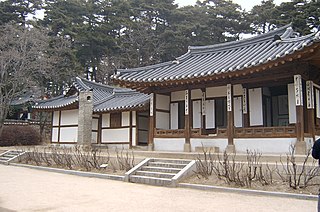
A hanok or chosŏnjip, is a traditional Korean house. Hanok were first designed and built in the 14th century during the Joseon dynasty.

Sejong or Sejong City, officially Sejong Special Self-Governing City (세종특별자치시), is a special self-governing city and the de facto administrative capital of South Korea.

Roof tiles are overlapping tiles designed mainly to keep out precipitation such as rain or snow, and are traditionally made from locally available materials such as clay or slate. Later tiles have been made from materials such as concrete, glass, and plastic.
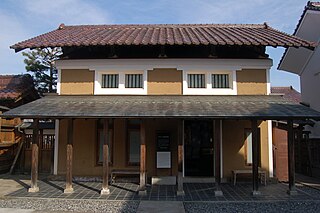
Kura are traditional Japanese storehouses. They are commonly durable buildings built from timber, stone or clay used to safely store valuable commodities.
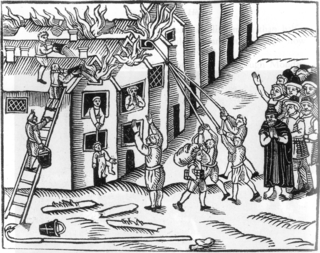
The Tiverton fire of 1731, also known as the Great Fire, was a fire that affected part of Tiverton, Devon in England on 5 June 1731. It was one of a number of serious fires affecting the town in the 17th and 18th centuries. Breaking out in a baker's house in Gold Street, the fire spread rapidly due to the prevalence of straw-thatched roofs in the town. In total 298 houses were destroyed in the fire which caused damage to the value of an estimated £58,976 14s. 9d. In response to the fire, a number of benefactors came forward to assist Tiverton in rebuilding. The fire resulted in the introduction of legislation that attempted to prevent a similar incident happening in the future.
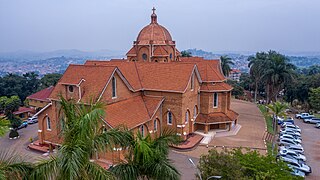
Saint Paul's Cathedral Namirembe, commonly and locally (Uganda) referred to as Namirembe Cathedral, is the oldest Anglican cathedral in Uganda. It serves as the provincial cathedral of the Anglican Church of Uganda and the diocesan cathedral for Namirembe Diocese, the first diocese to be founded in the Church of Uganda province in 1890. Between 1919 and 1967, the Cathedral served as the provincial cathedral of the Church of Uganda, Anglican Communion. In the 1960s, the headquarters of the Church of Uganda moved to All Saints Church in Nakasero then moved back to Namirembe later.
References
- 1 2 유, 승희 (June 2009). "15~16세기 漢城府의 주택 문제와 정부의 대응" [The Housing Problems of Hanseongbu and the Reaction of the Government during the 15th~16th Centuries]. 사학연구 (in Korean) (94): 60–61. ISSN 1225-133X – via DBpia.
- 1 2 신, 현배 (2023-10-31). "불을 끄는 '조선의 소방관'". Cultural Heritage Administration (in Korean). Retrieved 2024-11-23.